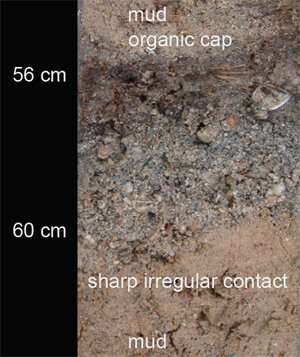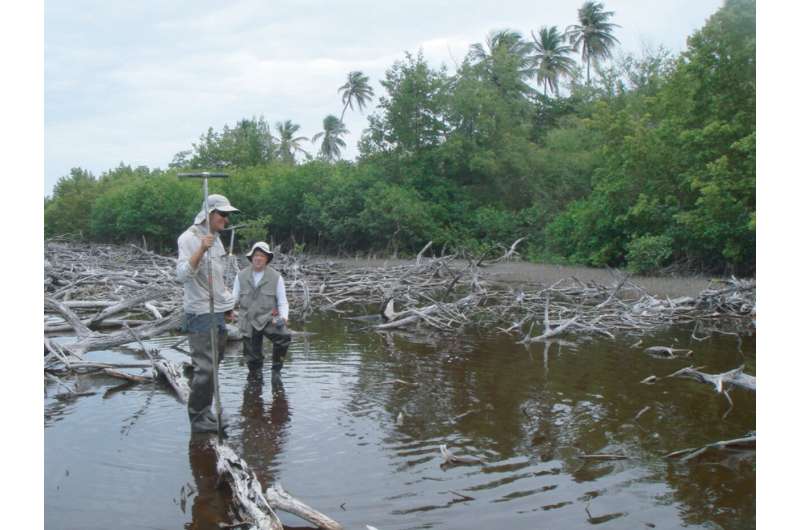This article has been reviewed according to Science X's editorial process and policies. Editors have highlighted the following attributes while ensuring the content's credibility:
fact-checked
trusted source
proofread
Puerto Rico tsunami deposit could have come from pre-Columbian megathrust earthquake

Tsunami deposits identified in a coastal mangrove pond in Northwest Puerto Rico could have come from a megathrust earthquake at the Puerto Rico Trench that occurred between 1470 and 1530, according to research reported at the Seismological Society of America (SSA)'s 2023 Annual Meeting.
These Puerto Rican tsunami deposits, along with similar age deposits at other islands in the Caribbean, suggest that the tsunami would have been triggered by a massive magnitude 8.7 or larger earthquake, said Bruce Jaffe of the U.S. Geological Survey.
The deposits could be important for understanding seismic risk in the region, since written records of tsunamis in the Caribbean extend back only 500 years, and the evidence for magnitude 8.0 or larger earthquakes on the Puerto Rico Trench is sparse.
Previous research has uncovered Caribbean tsunami deposits along the northern segment of the Lesser Antilles arc in Anegada, St. Thomas (U.S. Virgin Islands), Anguilla, and Scrub Island (British Virgin Islands).
The researchers estimate that these deposits, ranging in age from 1200 to 1500 years before the present, could be the result of a tsunami generated by a magnitude 8.0 to 9.0 earthquake that ruptured at least 300 kilometers.
If the Puerto Rico pond deposits came from the same event, "it could be a large length of fault that ruptured—400 kilometers, roughly," said Jaffe.
Earthquake modeling for the Lesser Antilles arc deposits suggested a magnitude 8.7 earthquake. Models that include the newly discovered Puerto Rico deposits indicate that the tsunami-triggering earthquake "would have to be quite a bit larger," he added.

The tsunami itself may have impacted both the Caribbean and Atlantic coasts of Puerto Rico.
Jaffe and colleagues scouted dozens of locations in Puerto Rico "looking for the right setting for a possible tsunami deposit to form and for it to be preserved," he said. In a coastal mangrove pond at East Bajura near Isabela in Northwest Puerto Rico, they found a likely candidate close to the shore and flanked by ancient dunes that could protect the pond from swells.
In sediment cores taken from the pond, the researchers found a thin sand sheet about a half a meter deep that blanketed the whole pond. The deposit bears several signatures of a tsunami event, including an eroded basal layer and a unique gradation of sediment particles.
Sediment swept up in the high-speed flow of a tsunami remains suspended in the water, "because the turbulent eddies are strong enough to mix the sediment from the [sea]bed all the way up through the water column," explained Jaffe, who has analyzed deposits in the wake of six major tsunamis worldwide. "It creates a very distinctive grading of sediment in the core."
The researchers are examining large cores taken from the pond with CT scans and X-ray fluorescence, among other tools, looking for fine details such as the direction of grass roots and the mineral composition of sediment grains to further constrain the timing and the source of the tsunami.
One of the researchers, Matthew Baez, a graduate student working with Jaffe and Alberto López-Venegas of the University of Puerto Rico, Mayagüez is looking for similar ponds along the north coast of Puerto Rico that could corroborate the findings from the East Bajura pond. Jaffe said there are plans to take a deeper core from the current pond to look for evidence of earlier tsunamis.
Study co-author López-Venegas said there has been a lack of paleo-tsunami research on major earthquakes affecting Puerto Rico's northern coast. The 2 May 1787 earthquake—which most likely occurred offshore the northern coast of Puerto Rico, likely centered on the Main Ridge within Puerto Rico Trench—is one of the most significant seismic events to affect that part of the island.
"The bottom line is, we still have a lot of work to do as we do not have a good grasp of which events have occurred along the Puerto Rico Trench, and much more paleo-tsunami work is required to understand better what has occurred in the past and what may happen in the future," López-Venegas said.
Provided by Seismological Society of America




















